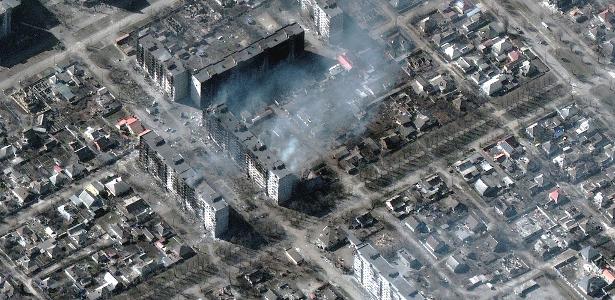Civilians risk themselves in convoys
3 min read
Hundreds of civilian cars strapped to their sides with white cloth and sheets of paper with the word “Children” plastered on their windows, on Wednesday morning (23) left for Mariupol in southeastern Ukraine. coastal city, It is Russia’s strategy In conflict, it is bombing targetFrom the early days of the invasion, civilians found it difficult to escape. today is The twenty-eighth day of the conflict.
At least 300,000 of the 400,000 residents have managed to leave the city, according to President Volodymyr Zelensky. The government stated that the Russians were preventing another 100,000 people from leaving the humanitarian corridor. And it is from these people that the caravan, hurriedly leaving the city of Zaporozhye, will try to save.
“I want to get my family out of this hell,” says Oleg, 47, one of the caravan members. He tried for the third time to go to Mariupol, where he lived and where his ex-wife, son, sister and nephew are still present. Since there is no connection, he has not heard from his relatives since March 2.
“I don’t even know if they’re still alive.”
He says that the other two rescue attempts failed, because he was not allowed to leave Zaporozhye.
Oleg told the report that he works with an international humanitarian organization and helps people who have been internally displaced across Ukraine. Now his family is in the same situation. Some relatives managed to leave Mariupol at the end of February. It remains to remove those who are still in the city. House Oleghe says, destroyed.
“Our relatives there are hungry and water shortage. “We need to get them out ASAP,” he says. “The only thing on my mind is that I need to get there, whatever it is.”
Repeated failures in the negotiations trying to determine the duration of the cease-fire prevent humanitarian agencies such as the International Committee of the Red Cross from accessing the city.
According to the reports of those who managed to escape, the residents still in Mariupol are living under the brutality of the constant attacks that have already destroyed most of the buildings and killed an unknown number of people.
“There is nothing left [de Maripuol]ruins only”
Volodymyr Zelensky, President of Ukraine
Caravans carried supplies, medicine, clothing, water, and even tools such as buckets, shovels, and heavy hammers to dig through the rubble. Civilians go on their own without any official support. “In five minutes we will leave by cars and try to get to Mariupol again. And if we fail, we will try tomorrow and the day after,” says Oleg.
If Russian forces approach him, he says he intends to remain calm. “We are all human beings, I think they will understand that we need to evacuate our relatives. I imagine they have families too. Anyway, I have no choice. I need to get my family out of this hell.”
* Specializing in conflict coverage, photographer André Liohn reports to UOL and Folha directly from Kyiv, Ukraine, on the war sparked by Russia. Through his publications in The New York Times, Time and The Guardian, Liohn was awarded the Robert Capa Award, one of the most important awards in photography, for his coverage of the Arab Spring in Libya in 2012.

“Devoted food specialist. General alcohol fanatic. Amateur explorer. Infuriatingly humble social media scholar. Analyst.”






